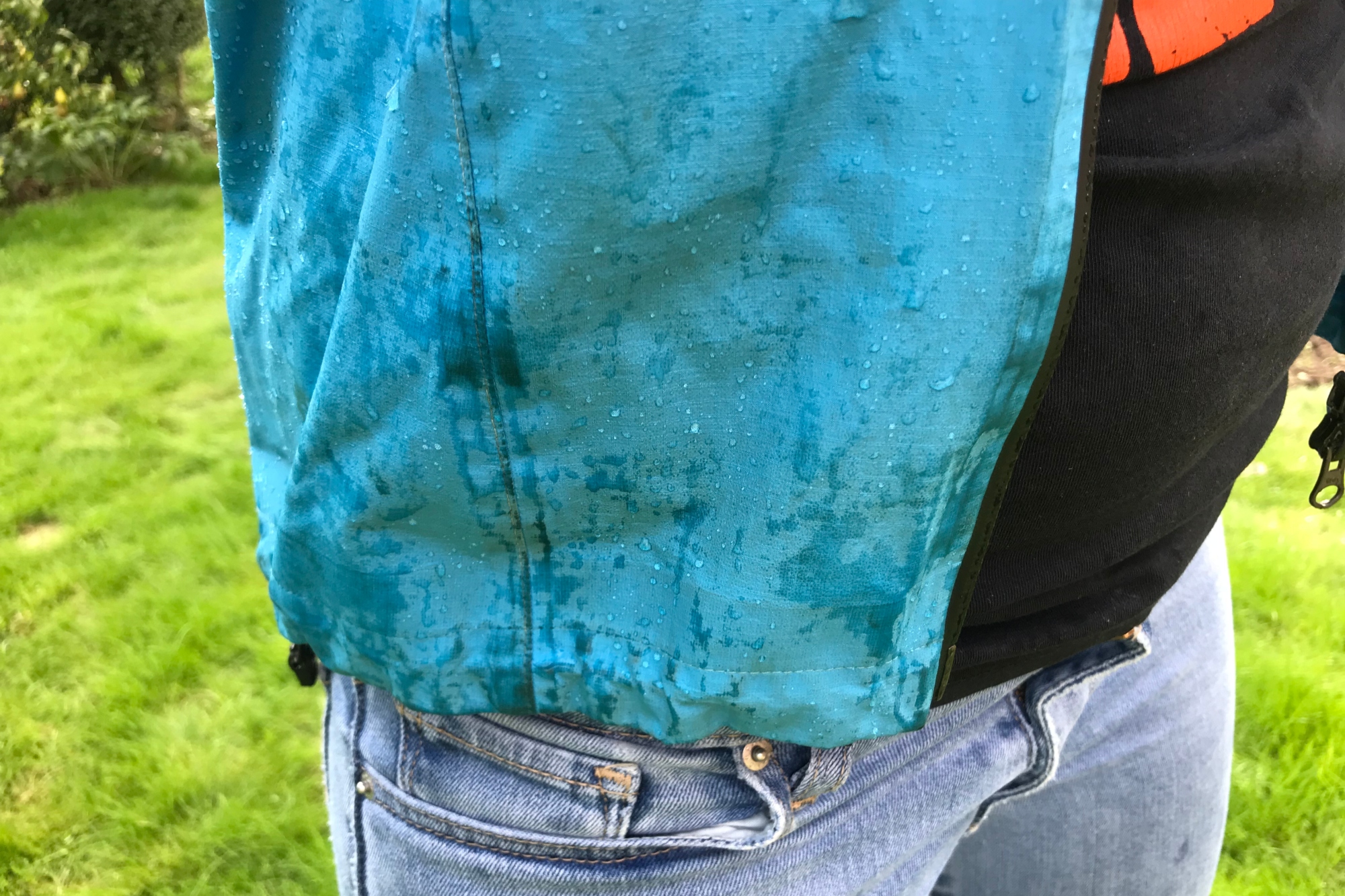Do cycling jackets have to get a lot worse for the environment to get a bit better?
As the legislation for removing harmful PFAS chemicals from the environment tightens, what does it mean for our favourite water and wind-blocking cyclewear?


It’s been two years since Gore announced the retirement of the Gore-Tex Shakedry technology. It was ahead of a ban on environmentally detrimental PFAS (polyfluoroalkyl) fabric that rippled out, state by state, from the USA and will soon be adopted by the European Union.
The shockwaves have been felt throughout the cycling industry ever since as it wasn’t just the iconic Shakedry jacket that had incorporated the chemicals. Almost all the fabrics used to construct the best waterproof cycling jackets use these chemicals. Brands were going to have to start again.
The undercurrent throughout this period of change has been the fear that all our wet-weather gear is about to get a lot worse at keeping us dry.
We caught up with a range of cyclewear brands to hear how they have adapted and overcome the challenge of going PFAS-free and what it means for your favourite cycling rain jacket.

Remco Evenepoel of Belgium and Team Soudal Quick-Step prior to the 103rd Tre Valli Varesine 2024 in the rain wearing Castelli rain jackets
Castelli
Castelli had been hit hard by the PFAS ban, with its iconic Gabba one of the first to feel the aftermath of the USA ban. Castelli quickly pivoted, with the reworked Gabba R.
Castelli Global Brand Manager, and one-half inventor of the original Gabba, Steve Smith, explained: "If you had asked me [about the legislation] even six months ago I would have been really negative.
"The brand explored a range of "non-permeable membranes", he said, but these simply left the rider wet on the inside.
Get The Leadout Newsletter
The latest race content, interviews, features, reviews and expert buying guides, direct to your inbox!
"A lot of fabric suppliers were going down this route, everyone was thinking about waterproofing but not breathability," he confesses, confirming that this was the cause for dissolving the long-time partnership with Gore-Tex fabrics.
"For some reason, the industry bought into a somewhat ridiculous measure of what can be defined as waterproof," says Smith, explaining that it's historically been tested to 10,000mm of water column, or the pressure of 10m of water pressing down on you. "If you’ve ever dived to 10m depth you know what that kind of pressure feels like", he says, adding that the standard was made so that you could sit with your full body weight in a puddle of water.
"In cycling, we don’t really have this level of pressure pushing against the water," Smith tells me, clarifying that a normal rainfall is equivalent to around 800mm water column, add the speed of the rider and, according to Smith, a cyclist will stay effectively waterproof at even 2000mm water column.
"Once again we have a 'standard' that’s made to sell over-engineered fabrics that go beyond what we really need, and sacrifices breathability in the process," states Smith, before he confirms that Castelli's newer Gabba R products have been tested to 5000mm of water column.
"We still have waterproof shells" he explains, before concluding that waterproofing has not been taken off the table, but you'll be dryer and more comfortable all day in something much more breathable.

Santini
Cycling rainwear tech breakdown

The fabric of most waterproof jackets is a sandwich of three layers: an outer with a durable water-repellent (DWR) treatment that visibly beads water as it is repelled, a breathable waterproof membrane in the middle and a softer knit next to the skin. Gore-Tex Shakedry eliminated the outer layer, exposing the PFAS-containing ePTFE membrane, and didn't need a DWR coating. This is what made it so light, waterproof and breathable — and convenient since it never needed reproofing. The challenge now is to recreate this without using PFAS chemicals.
As a brand that hasn’t used Gore-Tex fabrics since 2017, choosing instead to work with fabric house Polartec, Santini says it was ready to phase out PFAS fabric much sooner than some cycling clothing brands.
"Fabric has to function harder as the person perspires, and a cyclist gets to that point much quicker than someone going for a walk in a forest," says Santini Creative Director, Fergus Niland.
"The critical metric [in cycling] is the air exchange, to stop you wetting out from the inside out" adding that it's this internal build-up of sweat that is responsible for getting cold on a wet ride," he adds, explaining the challenges behind creating a breathable waterproof membrane.
Made with Bio-nylon, which Polartec says contains 48 percent plant-based content, the Polartec Power Shield Pro fabric that Santini uses for many of its top water-repellent jackets, while PFAS-free, reverts to the three-layer membrane system, which Niland confirms will require PFAS-free DWR re-treating over time.
Last week Santini launched its Magic rainproof jacket, which is one of the first garments to use the new Polartec Power Shield RPM fabric, a very lightweight, elastic, packable and highly breathable material. The fabric is made from eco-friendly, recycled polyester.

Michael Storer, Tudor Pro Cycling Team at Giro d'Italia 2024, Stage 17, wearing Team ASSOS rain jacket
Assos
What are PFAS?

Polyfluoroalkyl substances (PFAS), known as ‘forever chemicals’, aren’t just used in cycling kit. Found in various foams, pacemakers, non-stick pans and thousands of everyday products, PFAS are resistant to heat, oil, grease and, crucially for cycling, water. The problem is that they don’t break down, finding their way into water systems, soil, and us. The chemicals have been linked by scientists, including the United States Environment Protection Agency and European Environment Agency, to serious health and environmental problems.
An exception to PFAS-free pivoting is Assos. The brand’s Senior Manager of Development, Luca Zanasca, and Textile Expert, Claudio Lanfrancon, confirmed that it is only starting to remove the fabric from its collections, with summer 2025 seeing the first changes, and the brand hoping to be PFAS-free by autumn/winter 2025/ 26.
Asking the pair more about the expected performance of these new incoming fabrics, Lanfrancon explains that "there will not be a very perceptible difference for the rider," adding that users might notice a bit less water resistance.
"We have big changes planned for 25/26,” Zanasca lets slip. "Winter clothing performance will remain the same, but accessories will avoid waterproofing."
Quizzing Zanasca more, he tells me that a lot of the focus will be on the brand's best-selling Mille GTS [Wasserschnause] Rain Jacket S11. "A new version will improve on the last iteration, with similar waterproofing, but improved breathability," he says, before concluding that "it’s not just a case of making a rain jacket, its application and fit are just as important".

The Altura NightVision Storm rain jacket is a favourite with the UK commuter cyclists
Altura
Serving the UK riders only, the British brand Altura is not at the behest of any US or EU PFAS legislation. That said, Head of Own Brand, Ian Young was keen to press that Altura is still working to remove the forever chemical from its fabrics, stating: "It’s the right thing to do, especially for a brand working directly with the outdoors".
Young says that the well-known Altura Night Vision range is almost PFAS-free, but legacy stock is still in circulation.
Young confirmed that when comparing the older PFAS-based fabric on the Night Vision range, to the new version, the water-proofing won’t last as long.
"New fabrics just require you to wash and retreat more often. It’s not going to be s**t out the box. You’ll just have to look after them a bit more," clarifies Young.
"If anything, new fabrics are going to be better" he adds optimistically. "They will be more robust and sustainable than the older Gore-Tex Shakedry [ePFE), which had a lot of usage restrictions, such as the risk of damage when using a rucksack or riding off-road."

The Women's Cinder Kinetic Waterproof Biking Jacket
RAB
Rab (Equip Deutschland GmbH group) has very much led the charge on PFAS-Free fabrics, as early adopters of the Gore ePE (PFAS-Free) fabrics.
Cycling Weekly has already covered the brand's move to providing Material Facts transparent data sheets for every piece of RAB apparel, and its road map to becoming completely PFAS-free can be found on the Rab website.
Equip Deutschland GmbH PR and Communications Manager for Europe, Sarah Kampf, informed me that the brand is now focusing on educating consumers who have "become very used to the performance of older PFAS waterproof fabric".
"The newer solutions perform differently and have a different look and feel when wet," admits Kampf, adding that fabrics now have to be treated and cared for differently after purchase, which she believes is the biggest challenge going forward.

The AlpKit Arro shell rain jacket
AlpKit
Award-winning independent outdoor brand AlpKit has gained a loyal following of UK customers who buy into the brand's ethical ethos.
Head of Clothing Ronnie Legg told me that the brand started moving away from PFAS-based DWRs more than five years ago, although, surprisingly the brand isn't yet PFAS-free.
Legg says the challenges are often due to limits with supply-chain options on small amounts of fabric where sources of PFAS can cross-contaminate garments, such as the oil in sewing machines.
According to Legg, PFAS-free DWR fabrics are an imperfect solution. "It’s not that it doesn’t repel water as well [compared to PFAS), but that it doesn’t repel oil," he says, explaining that dirt and contaminates can prevent the water-repellent effect, and will happen much quicker with PFAS-free DWR compared to the older formulations.
Legg reiterates the importance of customers doing more aftercare, washing, and re-proofing, which adding to customer demands for lighter-weight fabrics with higher levels of breathability, will mean a compromise on durability

Georg Steinhauser of Team EF Education - EasyPost in the Rapha rain jacket at the 20224 Tre Valli Varesine
Rapha
With Gore as a main fabric partner, Rapha was in a similar boat to Castelli when having to re-consider life without old PFAS-based fabrics. However, Rapha remained loyal to the brand and has just announced a new Rapha Gore-Text rain jacket.
Using the same new ePTE [PFAS-free] Gore-Tex fabric as the Gore Wear SpinShift rain jacket (see below), the rain jacket was launched amidst much fanfare and aplomb, boasting to be totally windproof, reliably breathable and durably waterproof.
Staking claim to the first performance wear use of the fabric, Rapha states that the three-layer membrane is as slimline as possible and guaranteed to keep you dry.
What is not guaranteed, however, is it actually being PFAS-free, which is interesting small print reading hidden beneath the big headlines.

The new GoreWear SpinShift cycling rain jacket
Gorewear
As a fabric house and clothing brand, Gore and Gorewear have been performing a double act when it comes to moving away from forever chemicals in its ranges, engineering an entirely new fabric, alongside designing it into rainwear. Having quietly announced the slow retirement of its groundbreaking Shakedry jacket and fabric two years ago, Gore had in fact already been working significantly longer on a replacement Gore-Tex ePE fabrics.
Launched back in 2021, the expanded PFAS-free Polyethylene (ePE) fabric is described by Product Specialist at GoreWare Christian Mayer as super thin and lightweight, while still capable of providing the same level of "durability and durable waterproofness".
The SpinShift GTX jacket, constructed using the new fabric, was launched earlier this year, with the brand using the opportunity to increase the use of sustainable textiles by incorporating a recycled face textile and a recycled and dope-dyed backer.
Michael Jean-Jacques Production Line Manager Gorewear explains the challenges of ensuring a sports-specific fit and minimising the bulk created from waterproof taped seams. Despite moving to a three-layer membrane, Gorewear tells me that when comparing its C5 GTX SD 1985 jacket and the new Spinshift GTX Jacket there's only a 37g increase (both size Large).
What does this mean for me?
It does appear that the old days of never ending water beading have come to an end, and, as many brands have put it, there's now an onus on us consumers to play our part in adapting to the 'new normal' when it comes to expectations of lifetime rainwear performance.
The big take-home message for riders is that aftercare will be paramount to the performance longevity of your future, or existing, PFAS-free cycling rain jacket.
We've tried to demystify how to re-waterproof your cycling gear using (environmentally friendly) DWR treatments, which should help remove some apprehension from sticking a, usually very expensive, jacket in the washing machine.

Thank you for reading 20 articles this month* Join now for unlimited access
Enjoy your first month for just £1 / $1 / €1
*Read 5 free articles per month without a subscription

Join now for unlimited access
Try first month for just £1 / $1 / €1
Hannah is Cycling Weekly’s longest-serving tech writer, having started with the magazine back in 2011. She has covered all things technical for both print and digital over multiple seasons representing CW at spring Classics, and Grand Tours and all races in between.
Hannah was a successful road and track racer herself, competing in UCI races all over Europe as well as in China, Pakistan and New Zealand.
For fun, she's ridden LEJOG unaided, a lap of Majorca in a day, won a 24-hour mountain bike race and tackled famous mountain passes in the French Alps, Pyrenees, Dolomites and Himalayas.
She lives just outside the Peak District National Park near Manchester UK with her partner, daughter and a small but beautifully formed bike collection.
-
 Trek, State and Specialized raise bike prices while other brands limit US releases — Is this just the beginning?
Trek, State and Specialized raise bike prices while other brands limit US releases — Is this just the beginning?As tariffs hit, the bike industry is forced to adapt, whether through price increases, limited releases, or a restructuring of supply chains
By Anne-Marije Rook
-
 How I got my non-cyclist friend hooked on riding bikes — and how you can, too
How I got my non-cyclist friend hooked on riding bikes — and how you can, tooWith a little bit of gentle guidance, “bikes aren’t my thing” can turn into “when’s our next ride?”
By Marley Blonsky